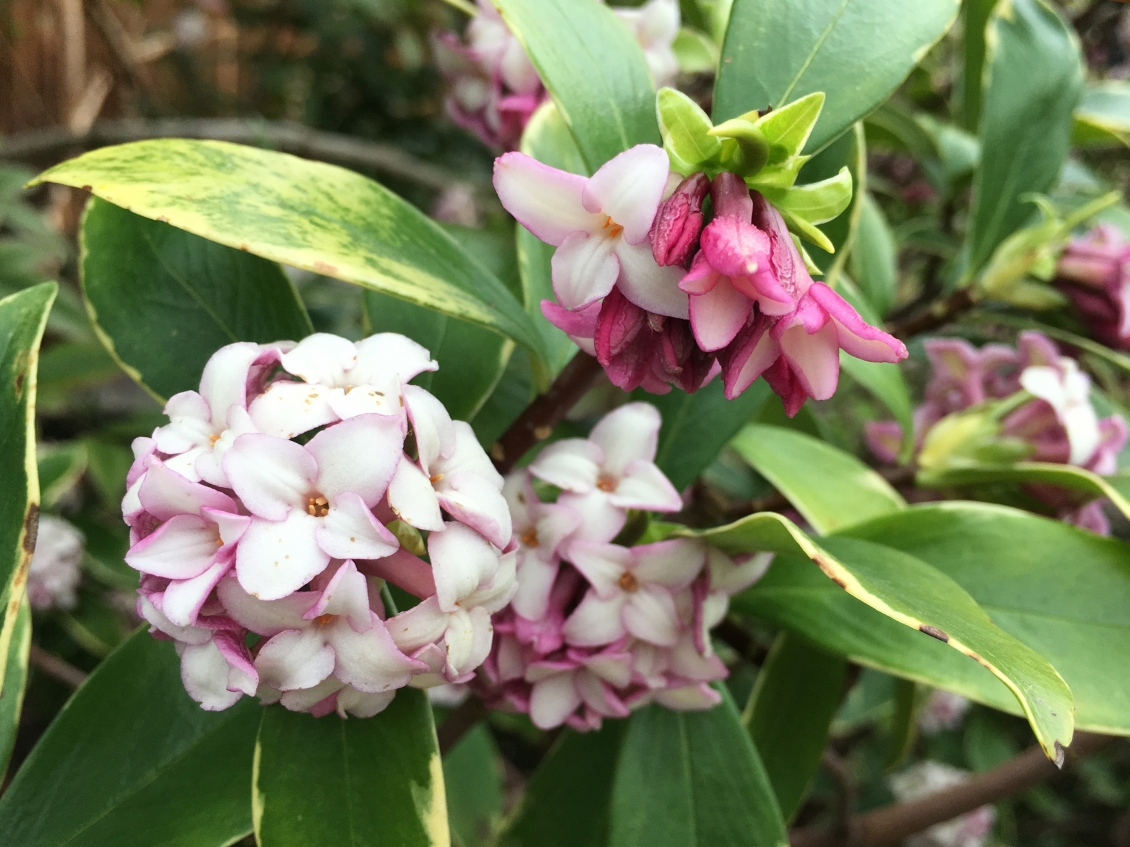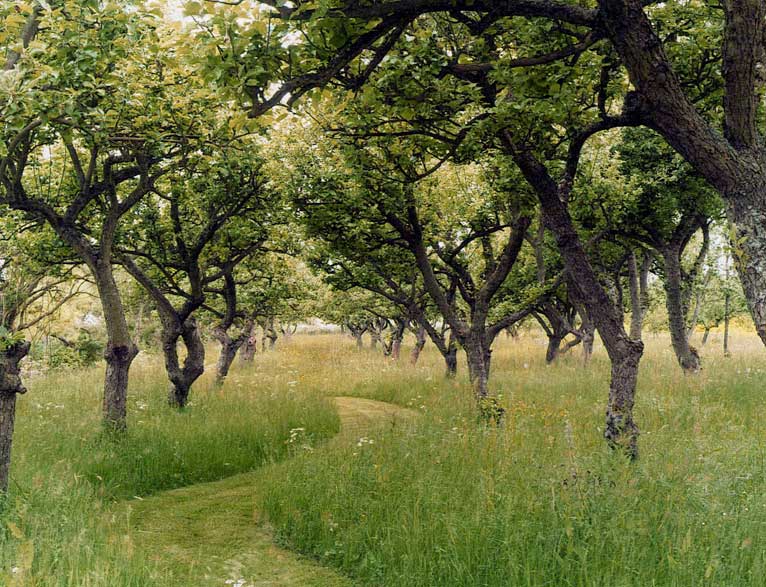
It’s March, and the rich scent of daphne punctuates the air as the first season of flowers bloom here in Eugene, Oregon. For many, daphne’s fragrance evokes the first teasing hints of spring. Above all other sensory experiences, scent has the power to conjure memory, triggering associations and adding depth to the present moment. It is elusive and yet ever present, from sweet floral notes of lilies and jasmine to the piercing greenness of freshly cut grass; from crisp autumn leaves and wood smoke to the rich dampness of rainfall. These scents permeate both our landscapes and our memories, inherently linked to seasonality. They represent experiences that are shared across backgrounds as well as unique personal moments. When carefully integrated into landscape designs, scented plants add richness and vibrancy throughout the seasons.
Fragrance can be harnessed in a design for many purposes. A particular scent can change your frame of mind or underscore the character of an outdoor room. For example, if you brush past the aromatic foliage of rosemary or lavender, they create a warm and soothing backdrop to the experience. Corsican mint underfoot makes an otherwise hot and sunny landscape seem cooler and more refreshing in the height of summer. Scents help transition from the hustle of everyday life into the peaceful space of the garden.
Careful crafting of spaces will enhance the sensory experience. Many scents are most pronounced in still air, so a garden enclosed by fences or vegetation will emphasize fragrance more than an open area. Designs that orchestrate the timing of a fragrance with the use of outdoor space maximize the impact of scents in a garden. Fragrant plants with early bloom times are especially welcome near a sunny place that is pleasant in the spring, while aromas near shadier spaces are better enjoyed in the hot summer months. Scents can be savored near places to pause and reflect, such as benches or gateways.
The role of fragrant plants is not limited to outdoor spaces. Strategic placement of scented plants will create fluidity between indoors and out. A fragrant plant near a window brings the garden into the home. A cutting garden will provide scented blossoms even if the weather discourages outdoor living. These sensory experiences anchor us in the present moment; they link us to the seasonal fluctuations in our lives, even as they harken to seasons past. At Lovinger Robertson Landscape Architects, scent is one of our favorite tools in crafting outdoor rooms, and we would love to help you incorporate fragrant plants into your landscape. Stop and smell the roses.
To cultivate a successful, self-sustaining orchard, you will need craft a strategy that balances interconnecting landscape considerations. The first step is to analyze your property to select the most optimal location for your future orchard. The key ingredient for a successful crop and healthy trees is an ideal microclimate. Of course fruit and nut trees require steady sun exposure, but they also need positive air movement. It is imperative to shape a space for your orchard where cold, moist air will not stagnate and collect.
 The layout and individual placement of your trees have much to do with encouraging beneficial air flow. The popular quincunx pattern persists through the ages because the trees are spaced equally apart, allowing each an equal share of soil nutrients while keeping a healthy distance between each individual tree. The aesthetic quality of a quincunx pattern adds to its appeal. It is the quincunx pattern that produces the magical experience of trees repeatedly snapping into perfect geometry as you move through and around an orchard.
The layout and individual placement of your trees have much to do with encouraging beneficial air flow. The popular quincunx pattern persists through the ages because the trees are spaced equally apart, allowing each an equal share of soil nutrients while keeping a healthy distance between each individual tree. The aesthetic quality of a quincunx pattern adds to its appeal. It is the quincunx pattern that produces the magical experience of trees repeatedly snapping into perfect geometry as you move through and around an orchard.
You must also consider the fertilization requirements of your selected trees. Some species of fruit trees require a pollination partner within close proximity in order to produce a good crop. Clearly, this information must be folded into the ultimate layout. Portland Nurseries produces useful reference guides that will help with choosing appropriate pollination partners.
To save space, you may choose self-fertile trees that do not require partners. Another strategy is to choose a family tree, which has different varieties grafted onto one rootstock. In Britain, a dedicated horticulturalist has managed to graft 250 different apple varieties onto one single tree!
Finally, think about how you want to choreograph your harvest. Do you want to time your harvest so that you receive a steady stream of fruit throughout the season? Or are you an avid canner or brewer who wants all the harvest to come in at once?
Obviously, this is a lot to wrap your brain around. Keep in mind that we can help with this complex business of orchard planning, especially if your orchard plans become the seed of inspiration for a larger reorganization of your landscape.

Does something flutter in your stomach when you drive past the straight lines and orderly patterns of an orchard? Do you love taking home an entire bushel of locally grown apples from your favorite pick-your-own orchard? If you find yourself nodding yes in response, a part of you must long for an orchard of your own. And you’re not alone. Many of us who live in the Willamette Valley desire to be part-time orchardists. During peak harvest times, Eugene is absolutely bursting with a bounty of apples, pears, filberts, cherries, plums, figs, and apricots.
But why is it that we Eugenians feel such an affinity towards orchards?
Homesteading on rural, suburban, and urban plots is particularly popular in our neck of the woods. Perhaps striving for self-reliance and sustainability appeals to our pioneer spirits. Perhaps it’s as simple as knowing that the food you grow yourself tastes better than anything you could buy at a store. There’s something about participating in a harvest that keys us into the rhythm of the seasons. Growing our own fruit and nuts is not only gratifying, it tunes us to into the landscape on an altogether deeper level.
Orchards tickle the part of our hearts and minds that tap into our collective landscape memory. Stretching back into time, orchards have been tightly woven into the idea of a tended garden. In “The Garden of the High Official of Amenhotep,” one of the oldest paintings of a planned garden, we see that fruit trees were integral to the composition of ancient Egyptian gardens. The orderly layout of an orchard symbolized the Romans’ ordered sense of the world. Romans even worshipped a goddess named Pamona who tended and protected fruit trees and orchards.
Reminders of our landscape’s agricultural past are all around us. Pre’s Trail in Alton Baker Park winds through remnant filbert orchards. Dorris Ranch in Springfield is the oldest filbert orchard in the United States. These are the places that we love to revisit. The scale of the orchard trees is relatable to the human body. They do not soar high above us, making us feel small and diminished. When arranged in orchard rows, the branches of individual trees form an arching ceiling over our heads, sheltering and protecting us. The trees are nourishing both to our bodies and our spirits.
You don’t need an entire orchard evoke the same feeling. Even if there is just one remnant apple tree on your property, you can build upon and continue that legacy with space-saving techniques.
If you think you are ready to start your own orchard, now is the time. Fruit trees are available for purchase in local nurseries. Also stay tuned to our Facebook and Blog pages - an upcoming post will outline the interconnecting aspects of orchard cultivation that you will need to consider during your planning phase.